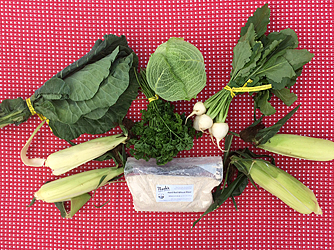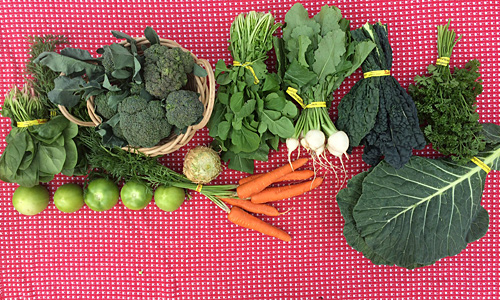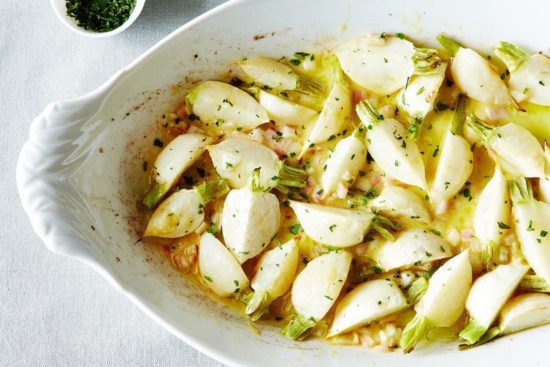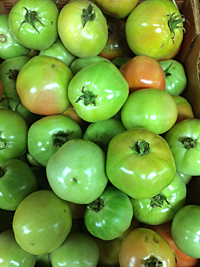
In the Small Box:
Green Savoy Cabbage 1 hd
Hard Red Wheat Flour 2 lb
Corn 4 ears
Curly Parsley 1 bu
Collards 1 bu
Apple Cider 1 qt
Baby White Turnips 1 bu

In the Standard Box:
Celery Root
Green Tomatoes 2 lb
Arugula 1 bu
Curly Parsley 1 bu
Collards 1 bu
Spinach 1 bu
Baby White Turnips 1 bu
Broccoli 1.5 lb
Bunched Carrots 1 bu
Lacinato Kale 1 bu
Baby White Turnips
Turnips taste earthy, but their baby selves taste sweet and creamy. They are even “cute,” if you can call a vegetable that. They lend themselves to many flavors. Try both the root and the greens in a sauté with lemon, garlic, and Herbes de Provence. Remember—you don’t need to peel these babies!
All turnips are very low in calories, with just 28 calories per 100 g. Nonetheless, they are a very good source of antioxidants, minerals, vitamins (especially C) and dietary fiber. Even the baby ones! Turnips help the body scavenge harmful free radicals, thus preventing cancers and inflammation, boosting the immune system.
Turnip greens are a storehouse of many vital nutrients, containing several times more than the levels in the roots. They are a good source of vitamins and antioxidants, such as vitamin A, B complex, C, K, carotenoid, xanthin, and lutein, as well as the minerals calcium, copper, iron, potassium, and manganese.
Baby white turnips are also very versatile. Here are some favorite ways to prepare them:
- Young turnips are one of the favored items in raw salads for their sweet taste, complementing cabbage, parsnips, carrots, beets, etc.
- They mix well with other vegetables like kohlrabi, potato, and carrots in stews.
- Diced sautéed baby turnips are delicious with poultry, lamb, pork, etc.
- Mix raw baby turnip slices with olives and cherry tomatoes in a vinaigrette for an appetizer.
- Turnip cubes are great pickled.
- Turnip greens are used like other hearty greens and vegetables, in soups, curries, and stews. Try them in a sauté with garlic, salt and pepper, and a little apple cider vinegar.
- Like all root veggies, turnips are fantastic roasted, as in the recipe below.
Roasted Baby Turnips

1 bunch baby turnips, and chopped into quarters
1 Tbsp. olive oil
Pinch of salt, to taste
Dijon-Shallot Vinaigrette
1 Tbsp. white wine vinegar
1/2 Tbsp. Dijon mustard
2 Tbsp. extra-virgin olive oil
1 small shallot, finely minced
Pinch of salt, to taste
1/2 Tbsp. dried tarragon
Preheat oven to 400° F. Toss baby turnips in olive oil and salt. Spread in a single layer on a baking sheet. Roast for 10 to 15 minutes, or until soft on the inside, with a slightly caramelized exterior.
While turnips are roasting, whisk together the white wine vinegar and Dijon mustard. Slowly whisk in the olive oil, taking care not to add too much at a time. Whisk until emulsified, then whisk in the shallots, salt and tarragon. Toss in the roasted turnips. This is best served at room temperature.
Mexican Grilled Corn
4 ears corn
1/2 cup mayonnaise
1 1/2 cups sour cream
1/4 cup freshly chopped cilantro leaves
1 cup freshly grated Parmesan
1 lime, juiced
Red chili powder, to taste
2 limes cut into wedges, for garnish
Remove the husks of the corn but leave the core attached at the end for handling. Grill the corn on a hot grill or cast iron griddle until slightly charred. Turn so it gets cooked evenly all over. Mix the mayonnaise, sour cream and cilantro together. Grate the Parmesan in another bowl. While the corn is still warm slather with mayonnaise mix. Squeeze lime juice over the corn and shower with Parmesan. Season with chili powder and serve with extra lime wedges.
Green Tomatoes

Don’t know what to do with your green tomatoes, besides frying them? Sauté them with onion and olive oil, season to taste, then toss them with hot pasta and bits of feta cheese. Or substitute green tomatoes for tomatillos in a salsa recipe. Or put them on a pizza, or a quiche.
Of course, everyone automatically thinks of fried green tomatoes. Here’s an easy version:
Whisk 2 eggs and 1/2 cup milk together in a medium-size bowl. Scoop 1 cup Nash’s soft white flour onto a plate. Mix 1/2 cup Nash’s cornmeal, 1/2 cup dry bread crumbs and1/2 tsp. salt and 1/4 tsp. pepper on another plate. Cut your tomatoes into 1/2” slices. Dip them into flour to coat. Then dip them into the milk and egg mixture. Dredge in breadcrumb mixture to completely coat.
In a large skillet, pour vegetable oil (enough so that there is 1/2 inch of oil in the pan) and heat over a medium heat. Place tomatoes into the frying pan in batches of 4 or 5, depending on the size of your skillet. Do not crowd the tomatoes. When the tomatoes are browned, flip and fry them on the other side. Drain on paper towels and enjoy.
Collards—More than good for you!
Collards are also known as “non-heading cabbage” or “tree-cabbage” due to cabbage-like leaves that resemble a crown on top of the stem after removal of the leaves (after few harvests) from the bottom part of the stem.
They are a rich source of dietary fibers, vitamin B9, C, A, K and minerals such as iron, calcium, copper, manganese and selenium. 100 g of collard greens contains only 30 calories. They are especially noted for lowering cholesterol.
The stalks and leaves are edible. Add them to soups, stews and dishes made of various types of vegetables and meat. Fresh leaves can be used in salads and juices.
